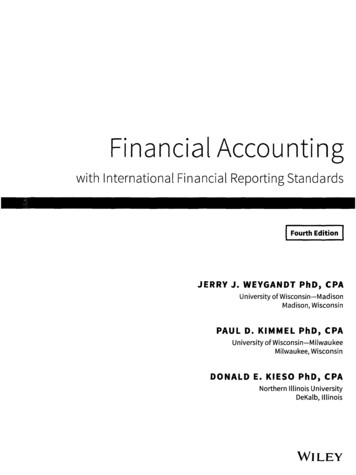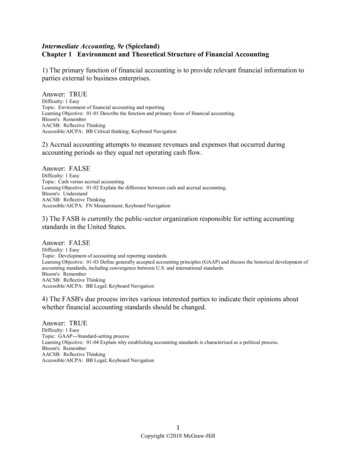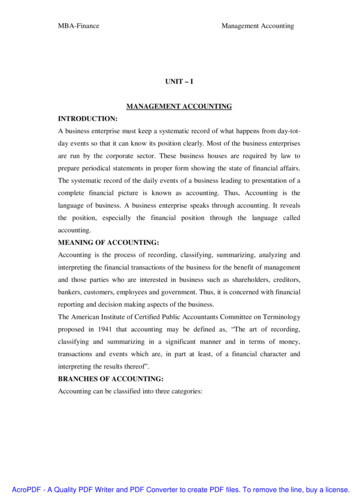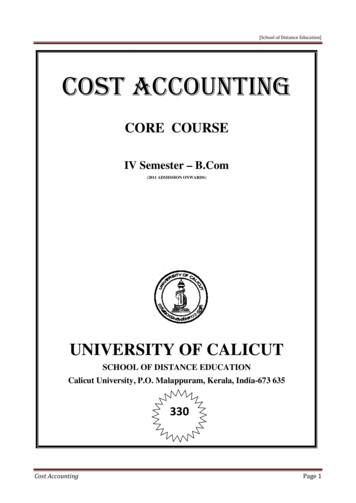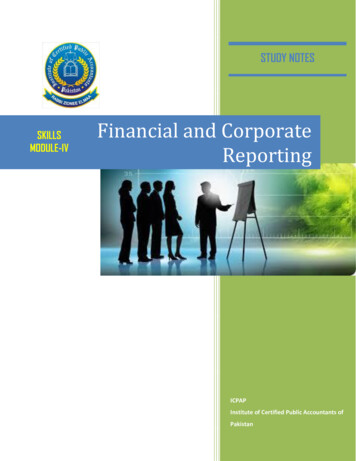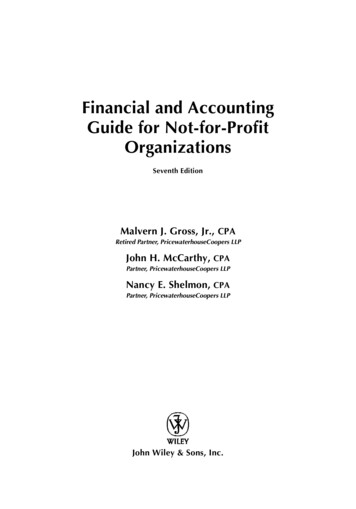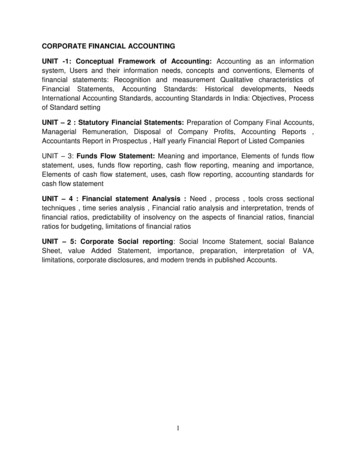
Transcription
CORPORATE FINANCIAL ACCOUNTINGUNIT -1: Conceptual Framework of Accounting: Accounting as an informationsystem, Users and their information needs, concepts and conventions, Elements offinancial statements: Recognition and measurement Qualitative characteristics ofFinancial Statements, Accounting Standards: Historical developments, NeedsInternational Accounting Standards, accounting Standards in India: Objectives, Processof Standard settingUNIT – 2 : Statutory Financial Statements: Preparation of Company Final Accounts,Managerial Remuneration, Disposal of Company Profits, Accounting Reports ,Accountants Report in Prospectus , Half yearly Financial Report of Listed CompaniesUNIT – 3: Funds Flow Statement: Meaning and importance, Elements of funds flowstatement, uses, funds flow reporting, cash flow reporting, meaning and importance,Elements of cash flow statement, uses, cash flow reporting, accounting standards forcash flow statementUNIT – 4 : Financial statement Analysis : Need , process , tools cross sectionaltechniques , time series analysis , Financial ratio analysis and interpretation, trends offinancial ratios, predictability of insolvency on the aspects of financial ratios, financialratios for budgeting, limitations of financial ratiosUNIT – 5: Corporate Social reporting: Social Income Statement, social BalanceSheet, value Added Statement, importance, preparation, interpretation of VA,limitations, corporate disclosures, and modern trends in published Accounts.1
UNIT I: CONCEPTUAL FRAMEWORK OF ACCOUNTINGStructure1.0Introduction.1.1Unit Objectives.1.2Accounting as an information system.1.3Parties interested in accounting information.1.4Specialized accounting fields.1.5Relationship of accounting with other disciplines.1.6Basic concepts of accounting.1.7Accounting standards and international accounting standards committee.1.8Accounting standards in India.1.9Summary.1.10Key Terms.1.11Questions & Exercises.1.0 INTRODUCTIONAccounting is known as the language of business. This designation is applied toaccounting because it is the method of communicating business information. The basicfunction of any language is to serve as a means of communication. Accounting dulyserves this function. The task of learning accounting is essentially the same as the taskof learning a new language. But the rapid change in business organization hascontributed to increase the complexities in this language. Like other languages, it isundergoing continuous change in an attempt to discover better means ofcommunications. To enable the accounting language to convey the same meaning to allstakeholders, it should be made standard. To make it a standard language certainaccounting principles, concepts and standards have been developed over a period oftime. This lesson based upon the different dimensions of accounting, accountingconcepts, accounting principles and the accounting standards.2
1.1 UNIT OBJECTIVESAfter reading this lesson, you will be able to: Know the Evolution of AccountingUnderstand the Definition of AccountingComprehend the Scope and Function of AccountingAscertain the Users of Accounting InformationKnow the Specialized Accounting FieldsUnderstand the Accounting Concepts and ConventionsRealize the Need for Accounting Standards1.2 ACCOUNTING AS AN INFORMATION SYSTEMEvolution of Accounting:Accounting is as old as money itself. It has evolved, as have medicine, law andmost other fields of human activity in response to the social and economic needs ofsociety. People in all civilizations have maintained various types of records of businessactivities. The oldest known are clay tablet records of the payment of wages inBabylonia around 600 B.C. accounting was practiced in India twenty-four centuries agoas is clear from kautilya’s book ‘arthshastra’ which clearly indicates the existence andneed of proper accounting and audit. For the most part, early accounting dealt only withlimited aspects of the financial operations of private or governmental enterprises.Complete accounting system for an enterprise which came to be called as “double entrysystem” was developed in Italy in the 15th century. The first known description of thesystem was published there in 1494 by a Franciscan monk by the name Luca Pacioli.Accounting is practiced by every one of us in our day to day life. An individual,who is working with an organization, earns his salary every month. From this salaryamount, he goes on spending money, on various household items, such as clothing,medicines, grocery, milk, tuition fees etc. Many people maintain diaries wherein allthese expenses are recorded every day. At the end of a month, such a person cansummarize these expenses and prepare a statement to ascertain the amount he is leftwith. The amount so available will be his savings at the end of that particular month.3
Everyone knows that “man must cut his coat according to his cloth “. If a mancarelessly spends money, he will be left with no money sooner or later. This is also trueof a businessman. A businessman receives money from sale of goods or for renderingservices and spends money for payment of purchases, salaries to staff, rent electricityetc. He cannot remember what he received & what he spent at the end of month or aparticular period. Therefore, it is necessary for him to record these happenings(incomes & expenses) in a systematic way. This will enable him to know whether he hasmade any profit or incurred any loss during a particular period.Definition & Features of accounting:The most commonly accepted definitions of accounting are as under:Accounting is defined as “an art of recording, classifying & summarizing in a significantmanner and in terms of money, transactions & events which are in part at least, of afinancial character and interpreting the results thereof.” Accounting is an art: Art is that part of knowledge which enables us to attainour objective & shows the way in which we may reach our objective in the bestpossible manner. It is an art because it helps us in attaining our objective ofascertaining the financial results by showing the best way of recording ,classifying & summarizing the business transactions .Recording: Accounting not only records the transactions of financial nature butalso records them in an orderly manner. The method of recording is adjustedaccording to the nature and size of the business. Thus, cash transactions, credittransactions, purchase & sale of fixed assets etc are recorded in differentways.Classifying business transactions: The classification or grouping is done byopening different accounts in a separate book called ledger. For example, alltransactions relating to purchases are shown on one page from the differentbooks of account, cash book, and credit purchases from purchase book.Summarizing: This is the art of presenting the classified data in the ledger, in anunderstandable and useful manner to the management or other interestedparties. This involves preparation ofo Trial Balanceo Trading & Profit and Loss Account &o Balance SheetRecords transactions in terms of money: Accounting records the transactionsby expressing them in terms of money. This makes the transactions moremeaningful. Thus, if the business has 06 machines, 10 tonnes of raw materials,20 tables, 10 fans etc. It is not possible to add them together or know which oneis more valuable unless they are expressed in terms of money.4
Records transactions of financial character: Accounting records only thoseevents and transactions which are of financial character. Poor lighting &ventilation, relationship between workers and management, though they affectthe earning capacity of the business cannot be recorded in financial books.These events cannot be expressed in terms of money.Interprets the financial data: Accounting involves recording, classifying &summarizing the financial events & finally preparation of final accounts. Theinterpretation of final accounts helps in making meaningful judgments aboutfinancial condition, profitability etc., which in turn help the management andother interested parties to take important decisions.Accounting as an Information System:Accounting as a “Language of business” communicates the financial results of anenterprise to various interested parties by means of financial statements which have toexhibit a “true and fair” view of its state of affairs. Like any other language, accountinghas its own complicated set of rules. However, these rules have to be used with areasonable degree of flexibility in response to specific circumstances of an enterpriseand also in line with the changes in the economic environment, social needs, legalrequirements and technological developments.BOOK KEEPING, ACCOUNTING & ACCOUNTANCY:According to G.A Lee, the accounting system has two stages The making of routine records , in prescribed form and according to set rules , ofall events which affect the financial state of the organization &The summarization from time to time of the information contained in the records ,its presentation in a significant form to interested parties and its interpretation asan aid to decision making by these parties .The first stage is called Book- keeping & the second stage is called Accounting.Book-keeping is mainly concerned with recording of financial data whereas theaccounting involves not only recording but also balancing of accounts , interpreting thebalances , ascertaining the business results by preparing Profit & loss account &Balance Sheet .The term Accountancy refers to a systematized knowledge of accounting and isregarded as an academic subject like economics, statistics etc. It explains “why to do”& “how to do” of various aspects of accounting. In other words, while accounting refersto the actual process of preparing & presenting the accounts; Accountancy tells us whyand how to prepare the books of account and how to summarize the accountinginformation & communicate it to the interested parties.5
Is Accounting a ‘Science’ or an ‘Art’?Any organized knowledge based on certain basic principles is a ‘science’.Accounting is also a science. It is an organized knowledge based on scientific principleswhich have been developed as result of study and experience. Of course, accountingcannot be termed as a “perfect science” like Physics or Chemistry where experimentscan be carried and perfect conclusions can be drawn. It is a social science dependingmuch on human behavior and other social and economic factors. Thus, perfectconclusions cannot be drawn. Some people, therefore, though not very correctly, do nottake accounting as a science.Art is the technique which helps us in achieving our desired objective. Accountingis definitely an art. The American Institute of Certified Public Accountants also definesaccounting as “the art of recording, classifying and summarizing the financialtransactions”. Accounting helps in achieving our desired objective of maintaining properaccounts, i.e., to know the profitability and the financial position of the business, bymaintaining proper accounts.SYSTEMS OF BOOK KEEPING:Book keeping is the art of recording transactions in a proper set of books. There aretwo systems of bookkeeping – Double Entry System Single Entry SystemDouble Entry System:1. Meaning- Double entry system is based on the principle that “every debit musthave a corresponding credit”. According to dual aspect concept, each businesstransaction has two effects; receiving of a benefit & giving of a benefit. Thus eachtransaction involves two accounts. Under this system, one account will be debited andthe other will be credited. The debit aspect is recorded or posted to the debit side of anaccount while the credit aspect is posted to the credit side of another account. It showsthat each and every transaction is recorded at different places in the ledger in twoaccounts.2. Principles of Double Entry System: - The following are the main principles ofdouble entry system – For every transaction two parties must be interested.6
Every business transaction has two aspects, one receiving of benefit and othergiving it. In simple words, Double entry system means “every debit has a correspondingcredit”. Both the aspects are recorded in the books of account. The two fold effect of a business transaction is recorded by debiting one accountand crediting the other account at the same time.3. Advantages of double entry system: Both the aspects of transactions are recorded simultaneously. They are equal inamount. Hence, this system ensures arithmetical accuracy of accounts. Under the system, all business transactions are recorded perfectly, completelyand systematically. Therefore, chances of errors and frauds are reduced. Under this system, it is easy to find out results of the business for any period andalso state of financial position on any day. Thus, under this system, the trader knows atany timeI. amount receivable from each customerII. Amount payable to each supplierIII. Expenses and income under each headIV. Amount spent on various assets The system enables the accountant, to prepare the annual accounts, profit & lossaccount and balance sheet. This system can be implemented by any organization.Single Entry System:Under double entry system of book keeping, both the aspects of each and everytransaction are recorded. This is known as dual aspect analysis. Under the single entrysystem, only one aspect of the transaction, personal is recorded and the other aspect isignored. For example goods sold on credit to a customer. Here only customer’s accountis opened and debited but goods account is not to be opened. Under this system, onlythe accounts which are absolutely necessary are maintained. Other accounts, nominal& real accounts are not opened except cash. The accounts maintained under thissystem are incomplete and unsystematic and therefore not reliable .The system isfollowed by small business firms.7
1.3 PARTIES INTERESTED IN ACCOUNTING INFORMATIONFollowing are the parties interested to know the accounting information: Owners: They have contributed capital to the business and hence are interestedin knowing the profits earned by the business & its financial position as on aparticular date.Managers: Managers are responsible for carrying on day to day business. Theaccounting information will help them in planning, decision making & controllingbusiness.Employees: Employees are interested in knowing profits made by the businessfrom year to year so that they can put forward their claims for higher wages &other benefits from the employees.Lenders: Banks & other financial institutions that have financed businessactivities would like to know how efficiently the funds lent by them are utilized.They would also like to know the profitability & financial soundness of thebusiness to satisfy them that their money will be safe & repayments will be madein time.Creditors: They are the suppliers of goods & services to the business on credit.They are interested in knowing the creditworthiness of the business to determinethe limits up to which credit can be granted.Government: Government departments collect income tax, sales tax, exciseduty etc. from the business houses. These departments are interested instudying the financial statements of the business enterprises. Government is alsointerested to keep a close watch especially on big business houses & largeindustrial undertakings as to how they are conducting their business.Prospective Investor: A person who wants to become a partner in the businessor purchase shares of a limited company would like to know how sales &profitable would be his investment.ADVANTAGES OF ACCOUNTING: Systematic Record: The financial transactions are recorded systematically indifferent books of account. The books of account will serve as historical records.Controlling & protecting business properties: Accounting helps to ensure thatthere is no unauthorized use or disposal of any asset or properties belonging tothe business, as proper records are maintained. The information about cash onhand , bank balance, closing stock of goods , amounts due from customers andamounts due to suppliers is available at any time This will enable themanagement to make use of these assets in the best possible way .8
Helps to Know Profit or Loss made: Accounting records help the managementto prepare profit and loss account for any particular period and balance sheet ason that date. These statements will show profit or loss made by the business andthe financial position of it.Rendering information to users: Various interested parties such as owners,lenders, creditors, government agencies and so on get the necessary informationabout the business.Facilitates rational decision making: By comparing its own business resultswith that of the earlier years or with those of its competitors, useful conclusionscan be drawn & suitable decisions can be taken to improve the performance.LIMITATIONS OF ACCOUNTING:The various concepts & conventions on which the principles of accounting arebased, to a large extent are responsible for the limitations of accounting. The limitationsare stated below: Accounting records only business transactions which can be measured in termsof money. Thus quality of product & human resources, locational advantages,licenses possessed etc. do not find any place in books of account.Assets are brought into at historical costs, cost at which they were acquired andthey do not reflect current market values. Therefore, for an outsider who wishesto evaluate the business, Balance sheet is not much useful if it is notsupplemented by other information.Facts recorded in financial statements are greatly influenced by accountingconventions and personal judgments of the accountant or management.Valuation of inventory, provision for doubtful debts, and assumption about usefullife of an asset may differ from one business to another.1.4 SPECIALIZED ACCOUNTING FIELDSAs in many other areas of human activity, a number of specialized fields inaccounting also have evolved besides financial accounting. Management accountingand cost accounting are the result of rapid technological advances and acceleratedeconomic growth. The most important among them are explained below: Tax Accounting:Tax accounting covers the preparation of tax returns and the consideration of thetax implications of proposed business transactions or alternative courses of action.Accountants specializing in this branch of accounting are familiar with the tax lawsaffecting their employer or clients and are up to date on administrative regulations andcourt decisions on tax cases.9
International Accounting:This accounting is concerned with the special problems associated with theinternational trade of multinational business organizations. Accountants specializing inthis area must be familiar with the influences that custom, law and taxation of variouscountries bring to bear on international operations and accounting principles. Social Responsibility Accounting:This branch is the newest field of accounting and is the most difficult to describeconcisely. It owes its birth to increasing social awareness which has beenparticularly noticeable over the last three decades or so. Social responsibilityaccounting is so called because it not only measures the economic effects ofbusiness decisions but also their social effects, which have previously beenconsidered to be immeasurable. Social responsibilities of business can no longerremain as a passive chapter in the text books of commerce but are increasinglycoming under greater scrutiny. Social workers and people’s welfare organizationsare drawing the attention of all concerned towards the social effects of businessdecisions. The management is being held responsible not only for the efficientconduct of business as reflected by increased profitability but also for what itcontributes to social well-being and progress. Inflation Accounting:Inflation has now become a world-wide phenomenon. The consequences of inflationare dire in case of developing and underdeveloped countries. At this juncture whenfinancial statements or reports are based on historical costs, they would fail to reflectthe effect of changes in purchasing power or the financial position and profitability of thefirm. Thus, the utility of the accounting records, not taking care of price level changes isseriously lost. This imposes a demand on the accountants for adjusting financialaccounting for inflation to know the real financial position and profitability of a concern.Thus emerged a future branch of accounting called inflation accounting or accountingfor price level changes. It is a system of accounting which regularly records all items infinancial statements at their current values. Human Resources Accounting:Human resources accounting is yet another new field of accounting which seeks toreport and emphasize the importance of human resources in a company’s earningprocess and total assets. It is based on the general agreement that the only real longlasting asset which an organization possesses is the quality and caliber of the peopleworking in it. This system of accounting is concerned with, “the process of identifying10
and measuring data about human resources and communicating this information tointerested parties”.1.5 RELATIONSHIP OF ACCOUNTING WITH OTHER DISCIPLINESAccounting is closely related with several other disciplines and thus to acquire agood knowledge in accounting one should be conversant with the relevant portions ofsuch disciplines. In many cases they overlap accounting. The Accountant should have aworking knowledge of the related disciplines so that he can understand suchoverlapping areas and apply the knowledge of other disciplines in his own workwherever possible, or he can take the expert advice.a. Accounting and Economics: Economics is viewed as a science of rationaldecision-making about the use of scarce resources. It is concerned with theanalysis of efficient use of scarce resources for satisfying human wants. Thismay be viewed either from the perspective of a single firm or of the country as awhole. Accounting is viewed as a system, which provides data to the users topermit informed judgment and decisions. Some non-accounting data are alsorelevant for decision-making. Still, accounting provides a major database.Accounting overlaps economics in many respects. It contributed a lot inimproving the management decision-making process. But, economic theoriesinfluenced the development of the decision-making tools used in accounting.However; there exists a wide gulf between economists’ and accountants’concepts of income and capital. Accountants got the ideas of value, income andcapital maintenance from economists, but brushed suitably to make them usablein practical circumstances. Accountants developed the valuation, measurementand decision-making techniques which may owe to the economic theorems fororigin but these are moulded in the work environment and suitably tempered withreference to relevance, verifiability, freedom from bias, timeliness, comparability,reliability and understandability.b. Accounting and Statistics: The use of statistics in accounting can beappreciated better in the context of the nature of accounting records. Accountinginformation is very precise; it is exact to the last paisa. But, for decision-makingpurposes such precision is not necessary and hence, the statisticalapproximations are sought. In accounts, all values are important individuallybecause they relate to business transactions. As against this, statistics isconcerned with the typical value, behavior or trend over a period of time or thedegree of variation over a series of observations. Therefore, wherever a needarises for only broad generalizations or the average of relationships, statisticalmethods have to be applied in accounting data.11
Further, in accountancy, the classification of assets and liabilities as wellas the heads of income and expenditure has been done as per the needs offinancial recording to ascertain financial results of various operations. Accountingrecords generally take a short-term view of events and are confined to a yearwhile statistical analysis is more useful if a longer view is taken for the purpose.However, statistical methods do use past accounting records maintained on aconsistent basis. Accounting records are based on historical costs of fixedassets, while the current assets are valued at the current values. The newmethods of inflation accounting are an attempt to correct this situation. Thecorrection of values is made on the basis of the current purchasing power ofmoney or the current value of the concerned assets revalued from the data ofpurchase till the day of recording, charging depreciation on the current value, sothat the present value of the asset is in line with the current value of money. Allthis would require the use of price indices or the price deflators, which are basedon statistical calculations of price changes. The functional relations showingmathematical relations of one variable with one or more other variables arebased on statistical work. These relations are used widely in making cost or priceestimates for some estimated future values assigned to the given independentvariables. Several accounting and financial calculations are based on statisticalformulae. Statistical methods are helpful in developing accounting data and intheir interpretation.For example, time series and cross-sectional comparison of accountingdata is based on statistical techniques. Now-a-days multiple discriminate analysisis popularly used to identify symptoms of sickness of a business firm. Therefore,the study and application of statistical methods would add extra edge to theaccounting data.c. Accounting and Mathematics: Double Entry book-keeping can be converted inalgebraic form; in fact the first known book on this subject was part of a treatiseon algebra. The fundamental accounting equation will be discussed in detailunder ‘Dual Aspect Concept’ of this chapter. Knowledge of arithmetic andalgebra is a pre-requisite for accounting computations and measurements.Calculations of interest and annuity are the examples of such fundamental uses.While computing depreciation, finding out installments in hire-purchase andinstallments payment transactions, calculating amount to be set aside forrepayment of loan and replacement of assets and calculating lease rentals,mathematical techniques are frequently used. Accounting data are alsopresented in ratio form.With the advent of the computer, mathematics is becoming a vital part ofaccounting. Understanding mathematics has become must to grasp the decision12
models framed by statisticians, econometricians and the O.R.experts.Presentlygraphs and charts are being extensively used for communicating accountinginformation. In addition to statistical knowledge, knowledge in geometry andtrigonometry seems to be essential to have a better understanding about theaccounting communications system.d. Accounting and Law: An economic entity operates within a legal environment.All transactions with suppliers and customers are governed by the Contract Act,the Sale of Goods Act, the Negotiable Instruments Act, etc. The entity itself iscreated and controlled by laws. For example, a partnership business is controlledby Partnership Act. A company is created by the Companies Act and alsocontrolled by Companies Act. Similarly, every country has a set of economic,fiscal and labour laws. Transactions and events are always guided by laws of theland. Very often the accounting system to be followed has been prescribed bythe law. For example, the Companies Act has prescribed the format of financialstatements. Banking, insurance and electric supply undertakings also have toproduce financial statements as prescribed by the respective legislationscontrolling such entities. However, legal prescription about the accountingsystem is the product of developments in accounting knowledge. That is to say,legislation about accounting system cannot be enacted unless there is acorresponding development in the accounting discipline. In that way accountinginfluences law and is also influenced by law.e. Accounting and Management: Management is a broad occupational field,which comprises many functions and encompasses application of manydisciplines including those mentioned above. Accountants are well placed in themanagement and play a key role in the management team. A large portion ofaccounting information is prepared for management decision-making. Althoughmanagement relies on other data sources, accounting data are used as basicsource documents. In the management team, an accountant is in a betterposition to understand and use such data. In other words, since an accountantplays an active role in management; he understands the data requirements. Sothe accounting system can be molded to serve the management purpose.1.6 BASIC CONCEPTS OF ACCOUNTINGAs we know that accounting is an art of recording business transactions in asystematic way. For recording transactions certain basic rules are laid down. These arebased on experience, reason, usage and necessity. These are fundamental ideas orbasic assumptions underlying the theory and practice of financial accounting and arethe broad working rules for all accounting activities developed and accepted by theaccounting profession.13
ACCOUNTING CONCEPTSAt the recording stageAt the reporting stageGoing Concern ConceptBusiness Entity ConceptAccounting Period ConceptMoney Measurement ConceptMatching ConceptObjective evidence ConceptConservatism conceptHistorical Record ConceptFull Disclosure ConceptCost ConceptConsistency ConceptDual Aspect ConceptMateriality ConceptA. Concepts at the recording Stage: Business Entity Concept: A business is always separate from its owner. Theaf
financial statements: Recognition and measurement Qualitative characteristics of . statement, uses, funds flow reporting, cash flow reporting, meaning and importance, Elements of cash flow statement, uses, cash flow reporting, accounting standards for . as is clear from kautilya’s bo



